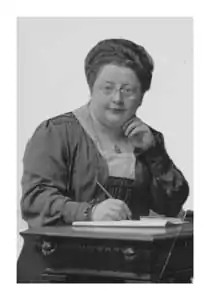Rosa Manus
Rosette Susanna "Rosa" Manus (Dutch pronunciation: [roːˈsɛtə syˈsɑnaː ˈroːsaː ˈmaːnʏs]; 20 August 1881 – 1942) was a Jewish Dutch pacifist and female suffragist.
Rosa Manus | |
|---|---|
Rosette Susanna Manus | |
 | |
| Born | 20 August 1881 |
| Died | 1942 |
| Known for | Sufferagist Women's rights advocate Pacifist |
Early years
Rosa Manus was born the second of seven children to affluent Jewish parents, Henry Philip Manus, a tobacco merchant, and Soete Vita Israël, a homemaker, in Amsterdam in the Netherlands.[1][2]
Women's suffrage and pacifism work
_-_pacifiste_-_feministe_-_portretschilderij_-_Collectie_Atria_-_Amsterdam.JPG.webp)
Manus became involved with the international women's suffrage movement in 1908 at the Congress of the International Woman Suffrage Alliance (IWSA). At the 1908 Congress she met Dutch suffragist Aletta Jacobs and American suffragist Carrie Chapman Catt, who would become lifelong colleagues and friends. Catt and Manus in particular developed a close relationship.[3]
Following the 1908 Congress, Manus became secretary of the Dutch Association for Women's Suffrage.[2] In 1913, Manus served as organizer, together with Mia Boissevain, of the exhibition "De Vrouw 1813–1913," on the lives of Dutch women.[4] In 1915, Manus played a large role in organizing the International Congress of Women in The Hague. Following this, she was appointed secretary of the International Committee of Women for Permanent Peace, later known as the Women's International League for Peace and Freedom (WILPF).
Manus accompanied Carrie Chapman Catt, then President of the International Woman Suffrage Alliance, on a world tour in 1922-1923.
In 1935, together with Johanna Naber and Willemijn Posthumus-van der Goot she established the International Archives for the Women's Movement (IAV), later known as the International Information Centre and Archives for the Women's Movement and currently known as Atria Institute on gender equality and women's history.[4]
Manus was made an Officer of the Order of Orange-Nassau by royal decree on August 22, 1936.[5]
Death
Manus was arrested by the Gestapo between August 10 and August 14, 1941[6] and deported to Germany. She was transferred to Ravensbrück concentration camp in October 1941.[7] She was likely gassed at Bernburg in 1942, but there is conflicting information around her date of death.[4]
See also
References
- "Rosa Manus | Jewish Women's Archive". jwa.org. Retrieved 5 June 2016.
- Commire, Anne; Klezmer, Deborah; Stavenuiter, Monique (1 January 1999). Women in world history: a biographical encyclopedia. Vol. 10. Waterford, CT: Yorkin Publications. p. 199. ISBN 078763736X. OCLC 41108563.
- Rupp, Leila J (1 January 1997). Worlds of women: the making of an international women's movement. Princeton, N.J.: Princeton University Press. pp. 190–191, 196–197. ISBN 0691016763.
- "Who was Rosa Manus?". Atria Institute on gender equality and women's history. 18 April 2016. Retrieved 5 June 2016.
- "Who was Rosa Manus?". Atria. 18 April 2016. Retrieved 25 August 2019.
- "Image 42 of Carrie Chapman Catt Papers: General Correspondence, circa 1890-1947; Manus, Rosette Suzanne; 1939-1941". Library of Congress, Washington, D.C. 20540 USA. Retrieved 25 August 2019.
- "International Women's News". February 1946. p. 50. Missing or empty
|url=(help)
External links
| Wikimedia Commons has media related to Rosa Manus. |
- Archief Rosa Manus Fonds, Atria, kennisinstituut voor emancipatie en vrouwengeschiedenis, Amsterdam, Netherlands